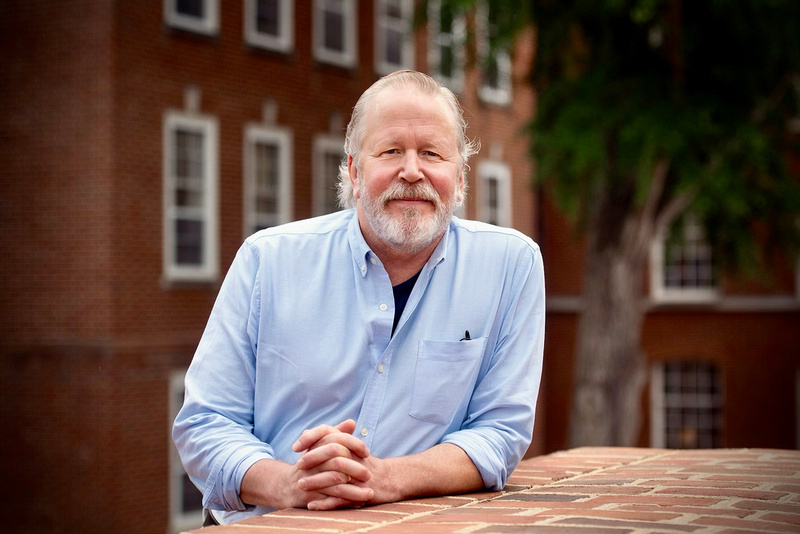News Detail
Author Sam Ligon Visits Woodberry Classes
This year’s White Family Writer-in-Residence is Sam Ligon, a Washington-based author who also teaches at Western Washington University. Sam is the author of four books of fiction, including two novels—Among the Dead and Dreaming and Safe in Heaven Dead—and two collections of stories: Wonderland, illustrated by Stephen Knezovich, and Drift and Swerve. Sam was on campus for two weeks in September, working with a number of English classes, and he will return to Woodberry in December.
The writer-in-residence program was established by Kip White ’99, Grant White ’00, and their parents, Gail and Fraser White III, for the purpose of bringing to campus professional artists who would spend time in the classroom getting to know the students, rather than just visit for a day or two.
“That’s a very important part of the program,” said English Department Chair Ben Hale. “We wanted to find someone who would be here for a while. Someone who would actually get to know the boys and teach a class. I’ve found that the way we’ve structured it is appealing to the writers and has an impact on our students.”
As Sam was wrapping up his fall visit and was preparing to head home to the Pacific Northwest, he was kind enough to answer a few questions about his Woodberry experience.
Q: How did you first get connected to Woodberry’s visiting writer program?
A: I got connected to Woodberry through English Department Chair Ben Hale. I met him in July 2023 at the Port Townsend Writers’ Conference, where I teach. We had a lot of writer friends in common, and I was friends with several of the previous writers to visit Woodberry, most specifically Ann Pancake. Before I knew anything about Woodberry, Ben was in one of my classes that week in Port Townsend. I think he was trying to see if I knew how to teach. At the end of that week, he told me about the visiting writer program and we started a discussion that led to me coming to Woodberry.
Q: What were your first impressions of Woodberry?
A: My first impressions of the school is that it was in a beautiful place. My first impressions of the students was that they were bright, focused, disciplined, and prepared for each class. They were also prepared to work. I had similar impressions of the faculty, an impressive group or teachers, writers, thinkers, and scholars. Another early impression was that the people at Woodberry — faculty and students — were not only bright and interesting, they were nice. And incredibly welcoming. I felt at home within a few days of being at Woodberry. That was a surprise.

Q: Can you describe what a typical day looked like for you?
A: A typical day for me was much busier than I had imagined it would be — but also stimulating. I taught two sections of senior creative writing for around two weeks, meeting with those sections four days a week. Additionally, I visited a lot of other English classes, teaching those sections for just one day each. Finally, I met one-on-one with several students about their writing and their futures — where they might go to school, career opportunities in various fields, and so on. I liked eating with students and faculty and talking with them inside and outside the classroom. I met a handful of parents at the football game and track meet. I found out that Woodberry days and weeks are full and busy. And I mean that in a good way.
Q: After spending a couple of weeks on campus, what are your thoughts about the school and, more importantly, the students?
A: I’d had no experience with private high schools or boarding schools before coming to Woodberry, though my wife attended an excellent private high school in Portland, OR. But I'm a product of public schools, as are my two older kids. After only a few days at Woodberry, I was starting to ask students and faculty a lot of questions about how such a school works. I was surprised that I was so quickly considering Woodberry or maybe a school like it in the West for my youngest son. I think the culture of support among these students, along with the cultivation within the culture of humility, encouragement, self-confidence, and work ethic all create an unusually strong learning and maturing environment. I had not realized the power of an all-boys or all-girls school. My wife's school had been all girls, and she thinks she got a better education as a result. I could not understand that, really, until I came to Woodberry, and found that I wanted what was happening there for my youngest son — even learning as I did from the juniors and seniors just how difficult that first year could be. That impressed me too — how they could talk so openly with me about that initial struggle — and how they made it through that struggle with the help of older students, faculty, and their families.
Woodberry Forest School is an exceptional private school community for high school boys in grades nine through twelve. It is one of the top boarding schools in the United States and one of the only all-boys, all-boarding schools in the country.
Explore & Resources
Woodberry Forest admits students of any race, color, sexual orientation, disability, religious belief, and national or ethnic origin to all of the rights, privileges, programs, and activities generally accorded or made available to students at the school. It does not discriminate on the basis of race, color, sexual orientation, disability, religious belief, or national or ethnic origin in the administration of its educational policies, admissions policies, scholarship and loan programs, and athletic or other school-administered programs. The school is authorized under federal law to enroll nonimmigrant students.





